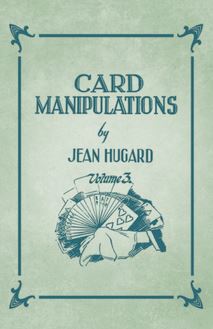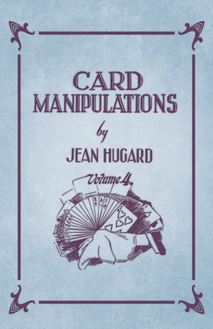-
 Univers
Univers
-
 Ebooks
Ebooks
-
 Livres audio
Livres audio
-
 Presse
Presse
-
 Podcasts
Podcasts
-
 BD
BD
-
 Documents
Documents
-
- Cours
- Révisions
- Ressources pédagogiques
- Sciences de l’éducation
- Manuels scolaires
- Langues
- Travaux de classe
- Annales de BEP
- Etudes supérieures
- Maternelle et primaire
- Fiches de lecture
- Orientation scolaire
- Méthodologie
- Corrigés de devoir
- Annales d’examens et concours
- Annales du bac
- Annales du brevet
- Rapports de stage
La lecture à portée de main
48 pages
English
Découvre YouScribe en t'inscrivant gratuitement
Je m'inscrisDécouvre YouScribe en t'inscrivant gratuitement
Je m'inscris
Obtenez un accès à la bibliothèque pour le consulter en ligne
En savoir plus
En savoir plus
48 pages
English
Obtenez un accès à la bibliothèque pour le consulter en ligne
En savoir plus
En savoir plus

Description
This is volume IV of Jean Hugard's fantastic handbook “Card Manipulations”, which includes simple instructions for a variety of fantastic tricks. Card manipulation is an element of magical illusion concerning the creation of effects through sleight of hand techniques that involve playing cards. It is commonly employed in magical performances, particularly in street magic. Jean Hugard (1872 – 1959) was an Australian professional magician. By the end of his life he had gone blind, having lost sight in both eyes as a result of cataract-removal operations. Despite his handicap he continued his work with magic at his home in Brooklyn, New York. Contents include: “The Gambler's Top Palm”, “The Change Over Palm”, “With Small Packet of Cards Only”, “With the Pack in Hand”, “New Top Change”, “Replacing Palmed Cards”, “Using a Table”, “On Bottom Deck”, etc. Other notable works by this author include: “Show Stoppers with Cards” (1948), “Royal Road to Card Magic” (1948), and “Houdini's 'Unmasking': Fact Vs. Fiction” (1957). Many vintage books such as this are increasingly scarce and expensive. It is with this in mind that we are republishing this classic volume now in an affordable, modern, high-quality edition complete with a specially-commissioned new introduction on card manipulation.
Sujets
Informations
| Publié par | Read Books Ltd. |
| Date de parution | 28 juin 2021 |
| Nombre de lectures | 0 |
| EAN13 | 9781528768146 |
| Langue | English |
| Poids de l'ouvrage | 2 Mo |
Informations légales : prix de location à la page 0,0350€. Cette information est donnée uniquement à titre indicatif conformément à la législation en vigueur.
Extrait
CARD MANIPULATIONS by JEAN HUGARD Volume 4.
Copyright © 2018 Read Books Ltd. This book is copyright and may not be reproduced or copied in any way without the express permission of the publisher in writing
British Library Cataloguing-in-Publication Data A catalogue record for this book is available from the British Library
Card Manipulation
Card manipulation is the branch of magical illusion that deals with creating effects using sleight of hand techniques involving playing cards. Card ma nipulation is often used in magical performances, to great effect, especially in close-up, parlour and street magic. Some of the most recognised names in this field include Dai Vernon, a Canadian magician with considerable influence, specialising in sleight of hand, Ed Marlo, an American born magician who referred to himself as a ‘cardician’, and Alex Elmsley, a Scot who was notable for his invention of theGhost Count or Elmsley Count, creating various mathematical card tricks, and for publishing the mathematics of card shuffling. Before becoming world famous for his escapology act, Houdini billed himself as ‘The King of Cards’.
Cards have a long and illustrious history, they wer e first invented in Imperial China, and specimens have been found dating back as early the ninth century, during the Tang Dynasty (618-907). Female players were some of the most frequent participants, and the first known book on cards, calledYezi Gexi (presumably written in the 860s) was originally wr itten by a Tang era woman, subsequently undergoing additions by other Chinese scholars. By the eleventh century, playing cards could be found throughout the Asian continent. During the Ming Dynasty (1368-1644), characters from novels such as thearginWater M were widely featured on the faces of playing cards. Playing cards first entered Europe in the early fourteenth century, probably from Egypt, with suits (sets of cards with matching designs) very similar to the tarot suits of Swords, Staves, Cups and Coins (also known as disks or pentacles). These latter markings are still used in traditional Italian, Spanish and Portuguese decks. Playing cards were first formalised into something closely resembling our modern deck in the seventeenth century, but the joker was only introduced by the USA in the 1870s.
As props, playing cards have only become popular with magicians in the last century or so, largely due to their inexpensive nature, versatility and easy availability. Although magicians have created and presented myriad of illusions with cards (sometimes referred to astricks), most of these illusions are generally considered to be built upon one hundred or so basic principles and techniques. Presentation and context (includingpatter, the conjurer's misleading account of what he is doing) account for many of the variations. Card magic, in one form or another, likely dates from the time playing cards became commonly known, towards the second half of the fourteenth century, but its history in this period is largely undocumented. Compared to sleight of hand magic in general and to cups and balls, it is a relatively new form of magic. Common manipu lation techniques include ‘lifts’, where one or more cards (normally known to the audience) are selected and identified as part of the illusion, ‘false deals’, which appear to deliver cards fairly, when actually the cards are predetermined or known to the performer, and ‘side slips’, a technique generally used to bring a predetermined card to the top of a deck. Passes, Palming, False Shuffles, False Cuts, Changes, Crimps, Jogs and Reverses are also commonly utilised manipulations.
-
 Univers
Univers
-
 Ebooks
Ebooks
-
 Livres audio
Livres audio
-
 Presse
Presse
-
 Podcasts
Podcasts
-
 BD
BD
-
 Documents
Documents
-
Jeunesse
-
Littérature
-
Ressources professionnelles
-
Santé et bien-être
-
Savoirs
-
Education
-
Loisirs et hobbies
-
Art, musique et cinéma
-
Actualité et débat de société
-
Jeunesse
-
Littérature
-
Ressources professionnelles
-
Santé et bien-être
-
Savoirs
-
Education
-
Loisirs et hobbies
-
Art, musique et cinéma
-
Actualité et débat de société
-
Actualités
-
Lifestyle
-
Presse jeunesse
-
Presse professionnelle
-
Pratique
-
Presse sportive
-
Presse internationale
-
Culture & Médias
-
Action et Aventures
-
Science-fiction et Fantasy
-
Société
-
Jeunesse
-
Littérature
-
Ressources professionnelles
-
Santé et bien-être
-
Savoirs
-
Education
-
Loisirs et hobbies
-
Art, musique et cinéma
-
Actualité et débat de société
- Cours
- Révisions
- Ressources pédagogiques
- Sciences de l’éducation
- Manuels scolaires
- Langues
- Travaux de classe
- Annales de BEP
- Etudes supérieures
- Maternelle et primaire
- Fiches de lecture
- Orientation scolaire
- Méthodologie
- Corrigés de devoir
- Annales d’examens et concours
- Annales du bac
- Annales du brevet
- Rapports de stage
Signaler un problème
YouScribe
Le catalogue
Le service
© 2010-2024 YouScribe







